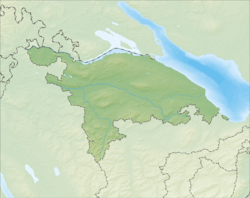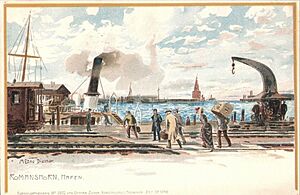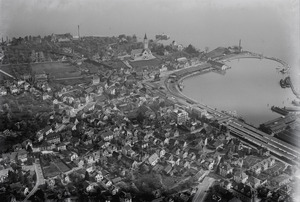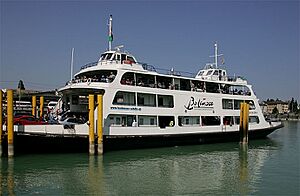Romanshorn facts for kids
Quick facts for kids
Romanshorn
|
||
|---|---|---|
 |
||
|
||
| Country | Switzerland | |
| Canton | Thurgau | |
| District | Arbon | |
| Area | ||
| • Total | 8.73 km2 (3.37 sq mi) | |
| Elevation | 406 m (1,332 ft) | |
| Population
(Dec 2020 )
|
||
| • Total | 11,327 | |
| • Density | 1,297.5/km2 (3,360.5/sq mi) | |
| Postal code |
8590
|
|
| Surrounded by | Friedrichshafen (DE-BW), Hefenhofen, Immenstaad am Bodensee (DE-BW), Salmsach, Uttwil | |
Romanshorn is a town, also called a municipality, in the Arbon district. It is located in the canton of Thurgau in Switzerland.
Romanshorn is a busy port town on Lake Constance. It is known for its important train station and ferry connections.
Contents
History of Romanshorn
Romanshorn was likely settled around the 7th century. The town was first mentioned in writing in the year 779. It was called Rumanishorn back then. This was in a document about land given to the Abbey of St. Gall, a famous monastery.
For many years, until 1367, parts of Romanshorn were owned by the Landsberg family. Later, in 1455, the head of the Abbey of St. Gall tried to sell Romanshorn. But his religious leaders stopped the sale. Until 1798, the Abbey of St. Gall collected taxes and had some legal power in Romanshorn. The rest of the control belonged to the County of Thurgau.
Church History
A church was first mentioned in Romanshorn in 779. By 1275, records show the church leader, called a Provost, was paid for his work. In 1480, the Abbey of St. Gall took over the church in Romanshorn. The church building was made bigger in 1504.
In 1525, the Protestant Reformation came to Romanshorn. Many people in the town changed their religion to Protestantism. For a while, the Protestant priest from nearby Salmsach also looked after Romanshorn. The church was shared by both Protestants and Catholics until 1911. That year, a new Protestant church was finished. Two years later, a new Catholic church was also built.
Growing Economy
Long ago, Romanshorn's economy relied on growing grains, fruits, and vegetables. People also worked in forestry and fishing. By 1902, some wine was made here too.
Romanshorn's port became very important. Steamboats started operating from Romanshorn in 1832. But the town really began to grow in 1844. That's when the Canton of Thurgau built a bigger port. Also, the mail route to Swabia (a region in Germany) started going through Romanshorn.
In 1855, a railway line opened connecting Zurich to Romanshorn. The next year, a telegraph cable was laid across Lake Constance. A train ferry line, which carried trains across the lake, opened in 1869. This ferry connected Romanshorn to Lindau in Germany. It was later replaced by car ferries in 1976. More railway lines opened between 1869 and 1910, connecting Romanshorn to places like Rorschach, Constance, and St. Gallen.
Romanshorn's great location after 1850 attracted many businesses. For example, the Fatzer company, started in 1836, first made ropes. Later, it began making steel cables. By 1985, it produced 2,000 tons of steel wire!
Another important company was Max Zeller & Sons. It grew from a pharmacy opened in 1864. This company made the famous Zeller balm. In 2008, it had almost 100 employees. The Swiss Alcohol Board also had a large storage facility here. The Voigt Pharmaceutical company, founded in 1904, became a global shipping company for medicines. By 2008, it employed about 250 people. Other well-known companies include Biro (plastics) and Hydrel (engineering).
Geography of Romanshorn
Romanshorn covers an area of about 8.75 square kilometers (3.38 square miles). A large part of this land, about 41.3%, is used for farming. Forests cover about 24.1% of the area. Buildings and roads take up about 33.4% of the land. A small part (0.5%) is rivers or lakes.
The town is located in the Arbon district, right on the beautiful Lake Constance. Romanshorn includes the main village and smaller areas called hamlets. These hamlets, like Holzenstein and Spitz, have mostly grown together with the main town over time.
People of Romanshorn (Demographics)
Romanshorn has a population of about 9,292 people. About 27.3% of the people living here are from other countries. Over the past 10 years, the population has grown slightly.
Most people in Romanshorn (about 83.7%) speak German. Albanian is the second most common language (3.3%), followed by Italian (2.9%).
In 2008, there were slightly more women (51.4%) than men (48.6%) living in Romanshorn. The town has a good mix of age groups. About 8.7% of the population are children aged 0-9 years. Teenagers (10-19 years old) make up about 12.1%. Adults aged 20-59 make up a large part of the population. Older adults (60 and above) make up about 25.1% of the population.
Most households in Romanshorn are private homes, with an average of 2.3 people living in each. Many people live in single-family homes or in buildings with two or three families.
In the 2007 Swiss federal election, the SVP was the most popular party, getting 35.31% of the votes. About 42.9% of people voted in that election.
Here's how the population of Romanshorn has changed over time:
| year | population |
|---|---|
| 1831 | 1,218 |
| 1850 | 1,408 |
| 1900 | 4,577 |
| 1950 | 6,648 |
| 1980 | 7,893 |
| 2000 | 9,076 |
Important Heritage Sites
Romanshorn has several important historical places. The Old Paritätische Church and the Catholic Church of St Johannes der Täufer are listed as heritage sites of national significance. This means they are very important cultural treasures for Switzerland. The entire village of Romanshorn is also recognized as a significant heritage site.
Economy and Jobs
Romanshorn has a low unemployment rate, which means most people who want to work can find jobs. In 2005, about 81 people worked in the primary economic sector. This includes jobs like farming, fishing, and forestry.
The secondary sector employs many more people, with 2,137 workers. This sector includes manufacturing and industry. The largest number of people, 3,085, work in the tertiary sector. This includes jobs in services, like shops, offices, and tourism.
Many people who live in Romanshorn also work there. About 35.1% of residents work outside the town, but even more people (2,820) come into Romanshorn for work. About 12% of workers use public transportation, and 40.4% use a private car to get to work.
Companies in Romanshorn
Here are some of the companies located in Romanshorn:
- Eftec AG
- Fatzer AG
- Geobrugg AG
- Eugster/Frismag AG
Transportation
Romanshorn railway station is a very important train hub. It opened in 1855. Different train lines meet here, connecting Romanshorn to cities like Winterthur, Schaffhausen, Rorschach, and St. Johann.
A special car ferry connects Romanshorn with Friedrichshafen in Germany, across Lake Constance. This ferry allows cars to travel directly between the two countries. From 1869 to 1976, there were even train ferries that carried entire trains across the lake!
Religion
Based on a 2000 survey, about 35.5% of the people in Romanshorn are Roman Catholic. About 36.3% belong to the Swiss Reformed Church (Protestant).
Other religions are also present. About 1.88% of the population belongs to the Orthodox Church. About 3.22% belong to other Christian churches. Around 11.04% of the population is Islamic. Some people belong to other churches, or do not belong to any church at all.
Education
In Romanshorn, many adults (about 61.9%) have completed higher education. This means they have gone to a university or a special college after high school.
Romanshorn has its own primary school district and a secondary school district (which also includes Salmsach). In the 2008/2009 school year, there were 731 students in primary schools. There were 185 children in kindergarten. The average class size in primary school was about 19-20 students.
In the secondary school district, there were 366 students. At this level, students are grouped based on how well they perform in their studies. There are advanced classes, standard classes, and special support classes for students who need extra help.
Festivals
Since 1999, Romanshorn has hosted the annual Festival of Nations every June. It's a celebration of different cultures and traditions.
Moc Moc
In 2004, a statue called "Moc Moc" was put up in Romanshorn. It was created by a Swiss artist group called Com&Com.
Notable People
Many interesting people have connections to Romanshorn:
- Johann Georg Birnstiel (1858 – 1927), a Swiss minister and writer, died in Romanshorn.
- Émile Taddéoli (1879 – 1920), a Swiss aviation pioneer and test pilot, died in Romanshorn.
- Antonio Ligabue (1899-1965), a famous Italian painter.
- Maria Stader (1911-1999), a Hungarian-born Swiss singer known for her beautiful voice. She grew up in Romanshorn.
- Christoph Sutter (born 1962), a teacher, poet, and writer.
Sport
- Peter Lüscher (born 1956 in Romanshorn), a former World Cup alpine ski racer.
- Daniel Lopar (born 1985), a Swiss football goalkeeper.
Images for kids
See also
 In Spanish: Romanshorn para niños
In Spanish: Romanshorn para niños










